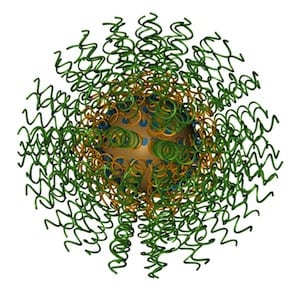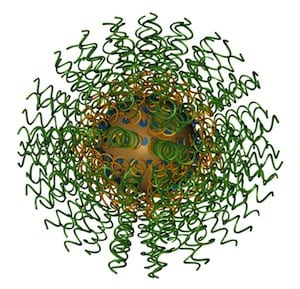
One of biotechnology’s most powerful tools is the introduction of nucleic acids of specific sequence into cells to implement a specific pre-determined change. Not surprisingly, nucleic acids incorporated into nanostructures are often much more functional than isolated nucleic acid molecules. It is sometimes not necessary for such nanostructures to be totally atomically precise, as has been demonstrated by Spherical Nucleic Acids (SNAs), dense conjugates of oriented nucleic acids on the surfaces of various nanoparticles, introduced by Chad Mirkin, winner of the 2002 Feynman Prize in Nanotechnology, Experimental. An informative animation available on the Mirkin group web site shows how SNAs are constructed and explains the advantages of SNAs, such as efficient entry into cells via endocytosis, resistance to nucleases, lack of unintended immunogenicity, and much better binding to intracellular nucleic acid targets. A recent success of the Mirkin group with SNAs is described over at KurzweilAI.net “Spherical nucleic acids train immune system to fight disease“:
A research team led by Northwestern University nanomedicine expert Chad A. Mirkin and Sergei Gryaznov of AuraSense Therapeutics has shown that spherical nucleic acids (SNAs) can be used as potent drugs to effectively train the immune system to fight disease, by either boosting or dampening the immune response. The initial treatment triggers a cell-specific immune response all over the body.
By increasing the body’s immune response toward a specific cell type, SNAs could be used to target anything from influenza to different forms of cancer. They also can be used to suppress the immune response, a tactic important in treating autoimmune disorders, such as rheumatoid arthritis and psoriasis, where the body’s immune system mistakenly attacks healthy tissues.
“The ability to selectively trigger the immune response with spherical nucleic acids presents a whole new way of thinking about drug development,” said Mirkin, a corresponding author of the study. “Once developed fully, SNAs will lay the foundation for developing an entire new pipeline of drugs to treat a range of diseases, from psoriasis, lupus and rheumatoid arthritis to lymphoma, bladder cancer and prostate cancer.” …
Additional details are available from Northwest University’s news release written by Megan Fellman “Spherical Nucleic Acids Set Stage for New Paradigm in Drug Development“:
The advantages of spherical nucleic acids in targeting the immune system include:
- SNAs are nontoxic. Cells take them up naturally without the conventional need for a secondary agent, which can result in toxicity.
- SNAs naturally go to the right place in cells. They enter via the endosome, a compartment where the immune system’s toll-like receptors (TLRs) are located. The TLRs are the controls of the immune system.
- SNAs are very potent. The single-stranded DNA on the nanoparticle core can be ideally positioned and oriented to specifically and fully interact with the targeted toll-like receptors. (Linear nucleic acids are delivered in random form and, therefore, do not engage the TLRs as effectively.)
The study [was published] by the Proceedings of the National Academy of Sciences (PNAS) [abstract].
Mirkin and his colleagues tested their SNAs head to head with known linear nucleic acids, targeting lymphoma and a form of autoimmune hepatitis. “The spherical nucleic acids always win from potency and speed standpoints, which corresponds with our understanding of their pathway of cellular entry,” Mirkin said.
The researchers design SNAs for individual targets. Different DNA sequences are used to engage specific toll-like receptors, which result in either a stimulation or suppression of the immune response, depending on what the goal is.
When an SNA with its nucleic acid shell approaches a cell, it is engulfed in the form of an endosome and taken inside the cell. Once in the endosome, the DNA strands of the SNA interact with toll-like receptor proteins (TLRs). The signaling of TLRs plays an essential role in the innate immune response.
In a study of mice, the researchers tested SNAs against lymphoma. For the animals treated with SNAs, the researchers found a significant decrease in tumor growth and a doubling of lifespan. The potency was up to an 80-fold increase over linear nucleic acids of the same sequence. In this case, SNAs trained the immune system to seek out and destroy lymphoma cells.
Next, focusing on nonalcoholic steatohepatitis (NASH), the researchers found eightfold increases in potency when animals were treated with SNAs and a 30 percent greater reduction in the animals’ fibrosis score. This observation has significant implications for treating liver cancer and cirrhosis patients.
“The beauty of the approach is that a very small amount of drug does a tremendous amount of work,” Mirkin said. “The SNAs trigger the immune response and, without more drug, additional cells are trained to behave the same way as the initial cells. This gives you a catalytic effect that grows into a systemic search for cells that look, for example, like lymphoma cells.”
Mirkin invented SNAs, new spherical forms of DNA and RNA, at Northwestern in 1996. SNAs are nontoxic to humans, making them a versatile tool in medicine.
The current study’s results show, Mirkin said, that if you want to make vaccines out of nucleic acids or if you want to modulate the immune system using nucleic acids, for vaccines or systemic suppression therapies, then the spherical nucleic acid architecture is likely the most potent.
The Mirkin group web site page Spherical Nucleic Acids (SNAs) provides an extensive bibliography documenting the range of options in terms of the various nanoparticle cores and the properties that they endow. Mirkin founded AuraSense Therapeutics in 2011 to commercialize the Spherical Nucleic Acid platform.
—James Lewis, PhD

